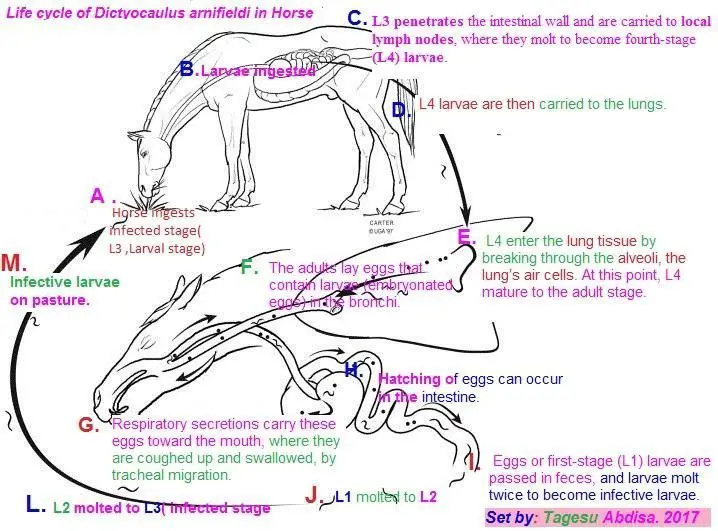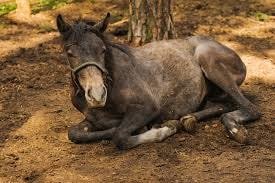The larvae of the equine Lungworm Dictyocaulus arnfieldi frequently found in fecal samples from donkeys; infection is rarely associated with signs of respiratory disease. In horses, on the other hand, lungworm in horses is often considered as a cause of chronic coughing, but the true prevalence of infection in the horse is not known since larvae are rarely found in the feces and at present, there are no other means of detecting their presence in the lungs.
Life Cycle and Epidemiology
Infection is by ingestion of infective third-stage larvae on pasture land. These larvae then travel from the intestine via the lymphatics and blood to the lungs where they develop to the adult stage in the bronchial tree. Adults females produce larvated eggs that are passed in the feces but this hatch almost after to first-stage larvae. The pre-patent period is a minimum of 2 months.

The epidemiology of lungworm infection in horses is poorly understood, but in the majority of confirmed cases, there is a history of the previously come in contact with donkeys. In the donkey, patent infections usually establish during their first season at the pasture and, in the absence of anthelmintic therapy, the majority of animals subsequently remain infected throughout their lives.
Pathogenesis of Lungworm in Horses
The presence of worms in the lungs produces valve-type lesions which lead to discrete, 3-4 cm areas of infection. Although infection is well tolerated in donkeys, the presence of lungworms in the horse can lead to chronic coughing.


Clinical Sings: Equine Lungworm Infection
Despite the prevalence of D arnfieldi in donkeys, clinical signs mostly attributable to lung-worm infection are rarely observed. In the horse, it has been shown that infection of young foals is associated with the development of patent infections in the absence of clinical signs. Infection of horse and ponies over 1 yr of age does not normally result in the establishment of patent infections but may be associated with marked clinical signs including coughing, increased respiratory rate, and adventitious lung sounds. It is also possible to detect lungworm larvae in feces samples from a very small proportion of apparently healthy horses.
Clinical Pathology of Lungworm in Horses
Laboratory tests of Lungworm in horses are of little value in the diagnosis. In very few cases, chronic coughing may be associated with a patent infection with first-stage larvae being found in feces. In contrast, in donkeys larvae are frequently found in the feces of apparently normal animals.
Post Mortem Findings of Equine Lungworm
Grossly raised circumscribed areas of overinflation are visible if the lungs are examined soon after death, but these can gradually disappear and may not be obvious if a post-mortem finding is delayed. Microscopically, there is hyperplasia of the bronchial epithelium, an increase in the size and number of goblet cells and infiltration of lymphoid cells around the airways. Often only a few parasites are presently coiled up in the lower bronchi, and these are difficult to recover.
Diagnosis of Lungworm in Equine
This is based on history, clinical manifestation, and examination of feces for D arnfieldi larvae, although in the horse patent infections are not common. A modified Baerman technique is used to test fecal samples for lungworm larvae. It is important to use fresh feces taken from the rectum otherwise free-living, and first-stage strongyle larvae may be present in fairly large numbers making an examination for first-stage D arnfieldi larvae difficult.

Treatment of Lungworm in Horse
Clinical trials have indicated that fenbendazole at a dose rate of 15-30 mg/kg is effective in the treatment of horses while in a controlled trial in donkeys treatment with mebendazole paste at a dose rate of 15-20 mg/kg daily for 5 days was shown to have a 75-100% efficiency against parasites in the lungs. However, ivermectin at normal dose rates is probably the drug of choice.
Control Measures of D arnfieldi
To reduce the risk of infection in horses, close contact with untreated donkeys should bo avoided. To reduce the overall volume of infection in donkeys, regular treatment( every eight weeks) with ivermectin is recommended: feces samples collected at the time of treatment should be examined to monitor the effectiveness of such a treatment regime.